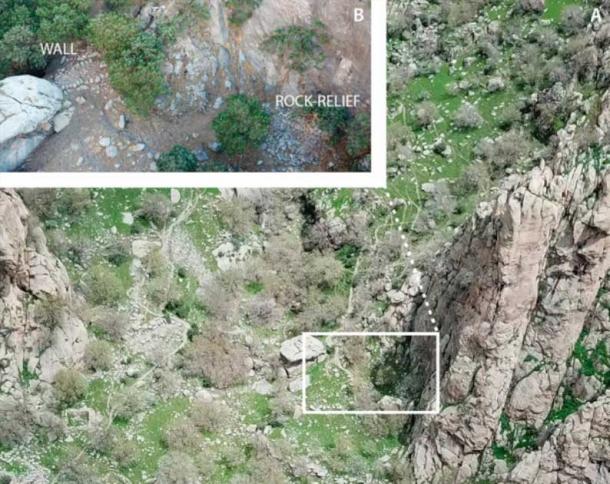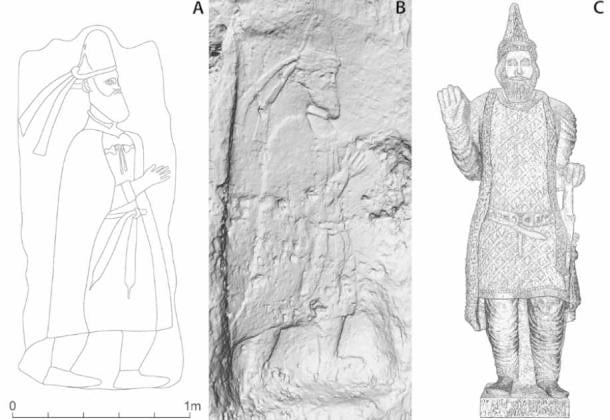
Lost Royal City of Natounia May Have Been Found in Zagros Mountains
An ancient, fortified settlement known as Rabana-Merquly, which was located high in the north-central Zagros Mountains of modern-day Iraqi Kurdistan, was protected by impenetrable fortifications constructed by the Parthian Empire in the first century BC. The settlement likely functioned as a military outpost and regional center, and would have been used to help the Parthians maintain control of the outer borders of their territory.
This is the conclusion of a team of German and Iraqi researchers who collaborated on an intensive study of the ruins of Rabana-Merquly, which was composed of two sister settlements built in the Rabana Valley and on the Merquly Plateau respectively. These fortified villages would have been found on the fringes of Parthian Empire territory, very close to the border of the Parthian client state of Adiabene (and perhaps even on the other side of that border). The industrious Parthians constructed nearly 2.5 miles (four kilometers) of rock walls to fill in gaps in the mountains that would have otherwise given invaders access to the valley and plateau, thereby guaranteeing the people who lived in Rabana-Merquly as much protection as would have been humanly possible at the time.
- Parthian Warrior Grave Accidently Unearthed During COVID-19 Burial
- Satraps of the Persian Empire – Rebellious Protectors of the Realm

A) Entrance to Rabana Valley; B) Rabana rock-relief with perimeter wall. (© Rabana-Merquly Archaeological Project / Antiquity Publications Ltd).
According to the researchers, who’ve just published their findings in the journal Antiquity, the identification of Rabana-Merquly as a defensive fortress of Parthian origin is significant because it reveals new information about the extent of Parthian power in the region. It specifically counters the assertion of many scholars that the Parthian Empire had only limited control of its outer borders, and therefore wasn’t capable of taking steps to protect them.
“The considerable effort that must have gone into planning, building, and maintaining a fortress of this size points to governmental activities,” stated Heidelberg University historian and study lead author Dr. Michael Brown.
The new study does reveal new information about how the Parthians protected the outer fringes of their empire. But what is drawing most of the attention is the German and Iraqi researchers’ tantalizing suggestion that the fortress at Rabana-Merquly might actually be the lost city of Natounia, a royal enclave supposedly constructed by the founder of the Adiabene kingdom, a legendary figure known as Natounissar. Natounia (Natounissarokerta) can be properly considered a lost city, since the only proof of its existence is a few first century BC coins that mention the city in their inscriptions.
- Mithridates Stalks His Prey, and Strikes a Killing Blow: The ‘King of Kings’ of Ancient Iran
- Did Augustus' Royal Coins Lead the Magi from Parthia to Bethlehem?
![Coin of Natounia, reverse. Inscription: NATOΥN / IEΩN T[ΩN] / ΠPOC TΩ / KAPΠΩ (© The Trustees of the British Museum / CC BY-NC-SA 4.0 / Antiquity Publications Ltd)](https://www.ancient-origins.net/sites/default/files/styles/large/public/Coin_4.jpg?itok=2t-OcDgp)
Coin of Natounia, reverse. Inscription: NATOΥN / IEΩN T[ΩN] / ΠPOC TΩ / KAPΠΩ (© The Trustees of the British Museum / CC BY-NC-SA 4.0 / Antiquity Publications Ltd)
Why Rabana-Merquly Might Really Be Natounia
Tellingly, an alternative name for Natounia was Natounissarokerta, which scholars say is a combination of Natounissar and the Parthian word for moat or fortification.
Beyond this intriguing clue, there are two major reasons why the archaeologists involved in this new study believe that Rabana-Merquly might be Natounia.
The first is their discovery of two life-sized rock-relief carvings located right next to entry gates in the fortifications that would have allowed people to enter or leave Rabana and Merquly. The two reliefs portray an individual believed to have been a king or important ruler. In each one a bearded figure of impressive stature is depicted wearing a tall, pointed hat and a long sleeveless cloak. His right hand is raised in a gesture of greeting, suggesting his approach is friendly.
The significance here is that these two reliefs closely resemble a statue excavated in the ancient city of Hatra, which is about 150 miles (230 kilometers) west of Rabana-Merquly. The statue found in Hatra is wearing a sheathed sword, while the figures carved into the rock by the Rabana-Merquly gates are not. But otherwise, the person depicted on the rock reliefs looks exactly like the man who served as the model for the statue, both in dress and posture—and the latter individual has been identified as an Adiabene king known as tlw/Attalos.

A) Merquly rock-relief; B) Rabana rock-relief; C) statue from Hatra of King ʾtlw/Attalos of Adiabene (illustrations by M. Brown; © Rabana-Merquly Archaeological Project / Antiquity Publications Ltd).
Needless to say, the presence of these life-sized carvings at the entrances to Rabana and Merquly suggest they were Adiabene settlements. At the time the fortifications were constructed, Adiabene was firmly established as a Parthian client state, which makes it perfectly understandable why the Parthians would approve of an Adiabene king being depicted as the guardian of the rock walls they built.
A second piece of evidence linking Rabana-Merquly to Natounia is its geographical setting. Natounia was referenced on the coins as supposedly being ‘on the Kapros,’ which is a Greek term that refers to a reservoir or watershed area. As it so happens Rabana-Merquly was built within the watershed boundaries of the Lower Zab River, and the borders of the kingdom of Adiabene were located in the region between the Upper Zab and Lower Zab. This shows that Rabana-Merquly at least can’t be ruled out as a candidate to be Natounia, since both were located in the same general geographical region.
The True Parthian Influence Revealed
At the present time, the theory that Rabana-Merquly was Natounia is built exclusively on circumstantial evidence. If future excavations at Rabana-Merquly produce objects with inscriptions that match those found on the coins that reference Natounia, that would function as more definitive proof.
But regardless of its real name, there is no question that what modern scholars call Rabana-Merquly was an important settlement. Great effort was made to protect it, even though evidence suggests the Parthians and/or their Adiabene clients didn’t maintain a presence there beyond the first century BC. Excavations have uncovered the ruins of several rectangular buildings that may have served as barracks for soldiers stationed at the fortress, and they’ve also unearthed the remains of a religious complex that appears to have been dedicated to the Zoroastrian Iranian goddess Anahita.
Rabana-Merquly would have been occupied by political and military representatives of the Parthian Empire, say Dr. Brown and his colleagues. It may have been built and ruled by their Adiabene clients, but they wouldn’t have done anything without Parthian approval.
Additionally, Rabana-Merquly is believed to have functioned as a busy marketplace for commerce and trade, since it was located along the Silk Road trade route that connected the Roman Empire with the Han Dynasty in China. This would have given the Parthians strong reason to provide ample protection to the people who lived there and supervised and facilitated its commercial activity.
Top image: Rabana ‘sanctuary, fortifications at the Rabana-Merquly. Source: © Rabana-Merquly Archaeological Project / Antiquity Publications Ltd
By Nathan Falde
















Comments
Well, you wouldn’t build something like that unless the place had a good water source, and you wouldn’t abandon a place like that unless the water dried up. But it does get a lot of rain up there in Spring, and there are limestone caverns (aquifers), so water should not have been the problem. Question then becomes, what wiped out the people who lived there? And when? Same big calamity that brought the sudden onset of the Ice Age? Good background info at the Wikipedia page: https://en.wikipedia.org/wiki/Zagros_Mountains
Nobody gets paid to tell the truth.